QuestionHi, my puppy (oldest male of his litter) has been with me a few weeks, he's generally very playful, but I'm concerned about his biting. It does seem to be merely play biting since when he's chewing on my hand, it's very light, but I'm concerned since there are often sometimes children in the house and my puppy's teeth are pretty sharp. Is there a way that I can discourage the habit?
Another thing is, he's pretty well potty trained now, but there are around three spots inside the house where he's "marked his territory," but since I really got him for companionship, is there a way that I can prevent him from using those spots?
Finally, what is the best way to reprimand him when he misbehaves?
Thanks in advance!
AnswerHere's a response I've written before about dealing with the play biting:
>>>>>>>>>>>>>>>>>>>>>>>>>>>>>>>>>>>>>>>>>>>>>>>>>>>
First, it is important to understand that dogs bite for two reasons: play and defense/aggression. Nipping and leaving red marks (and possibly breaking the skin now and then) is a normal sign of play. Siberians are well known for being an extremely playful breed, and also are well known for being very rambunctious when they play. This nipping is typical.
So, now that you understand that the dog is "playing" it should help you redirect the behavior. I personally encourage the playful interaction. Since dogs associate with their world through their mouths, and is the main way that they play, I think it shows a strong bond that the dog wants to play with an owner. So, rather than stop it, you have to set-up rules around the play. Once those rules are established, dogs generally have pretty quick time understanding and following the rules. Here's what I suggest:
First, get a pair of thick leather gloves. Ray Allen Manufacturing makes some, but you can also go to a hardware store and look for some really thick ones. I've also had luck finding leather welding gloves. They aren't cheap, but they last a long time and it's worth it for the dog. Next, put the gloves on and wrestle and play with your dog. The bites won't go through the gloves, and if the dog bites too hard and the pressure hurts, correct the dog. When play time is over (your decision), take the gloves off and put them away. If the dog tries to continue to bite/play, correct the dog. Soon, the dog will understand that gloves on equals playtime, gloves off means no.
As for the correction, it's a simple strong "NO!" and removing yourself from the situation. If the dog persists, a quick grab of the neck can also be effective. For the first few weeks, if the dog nips at you, immediately go get the gloves. This will also help teach the dog that means play. To this day, my dog (at 3 years old, and we started this method with her at 11 weeks old) will come up and bite my hand gently. I then go get the gloves and we wrestle.
<<<<<<<<<<<<<<<<<<<<<<<<<<<<<<<<<<<<<<<<<<<<<<<<<<<<<<<<<
As for discouraging it around other people, if the children live with you, you can train the kids to follow the same procedure. If they do not, usually I've noticed that the dog will still associate the gloves with play time, so you should be ok there. Once again however, it is important that any interaction with dogs and children be supervised.
As for the marking - it's common for male dogs. Here's another excerpt from a previous response that makes sense here:
>>>>>>>>>>>>>>>>>>>>>>>>>>>>>>>>>>>>>>>>>>>>>>>>>>>>>>>
First - you have to go back to day 1 of housebreaking, and follow it carefully and diligently. First - if you cannot watch the dog, then he is either in his kennel or outside. He is NEVER to be left in the house without someone watching him. If you can't watch him, put him up. Period. If the dog does eliminate in the house . . . roll up a newspaper and wack yourself repeatedly over the head yelling "bad owner! bad owner!" You weren't watching :)
The truth is, you have to watch him. As soon as he starts to sniff around to urinate, or lifts a leg to "mark" - yell NO! You have to catch him in the act. When he starts to go, yell NO! and escort him outside to his spot. Praise him there if he finishes. If you watch carefully, you should get pretty good at picking up on doggie signals about when he is looking for a place (sniffing in circles and walking his butt up to the exact place he sniffed, etc.).
If and when you are a bad owner ;) and your dog does have an accident in the house, it is important you follow two steps in cleaning it. First, use an enzymatic based cleaner which disinfects and eliminates the odor (even to the dog's super sensitive nose). Lysol or carpet cleaners are good, but you still need an enzyme based cleaner - check out a pet store and they should have something like Nature's Miracle. This will eliminate all trace of the accident to the dog, giving your house the appearance that he's never gone in there. And since dogs are creatures of habit, if you erase his evidence of prior elimination, you are that much closer to giving him a spot to go to OUTSIDE. The second important thing is when you do clean it, make sure your dog is no where to be found. This is a little known trick, but for intelligent and clean dogs they can out think you. See, they want a clean environment to live in too (which is why crate training works). They also are smart enough to know that if you are going to clean up after them, why do they need to worry about not eliminating in the house? See, they are just like kids . . . give them an inch . . .
So, clean up with them outside, kenneled, or in another room - never watching you.
<<<<<<<<<<<<<<<<<<<<<<<<<<<<<<<<<<<<<<<<<<<<<<<<<<<<<<<<
While that response was to encourage normal house training, it should work for marking just as well.
As for your last question - best way to reprimand your dog completely depends on what the dog has done wrong. Verbal "NO!" and a quick grab of the neck are usually most effective. Collar corrections (quick "pops" of the collar) are also extremely effective for corrections when on lead. If you run into specific instances that you are having trouble with, let me know. Generally, keep in mind how dogs communicate though. A LOT can be communicated in tone and posture, and that will be the most effective way to get through to your dog.

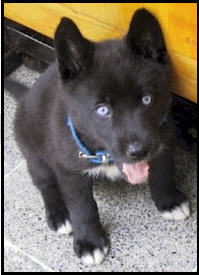 Crate Training a 7wk old Husky mix pup
QuestionHusky look-alike from
QUESTION: Weve re
Crate Training a 7wk old Husky mix pup
QuestionHusky look-alike from
QUESTION: Weve re
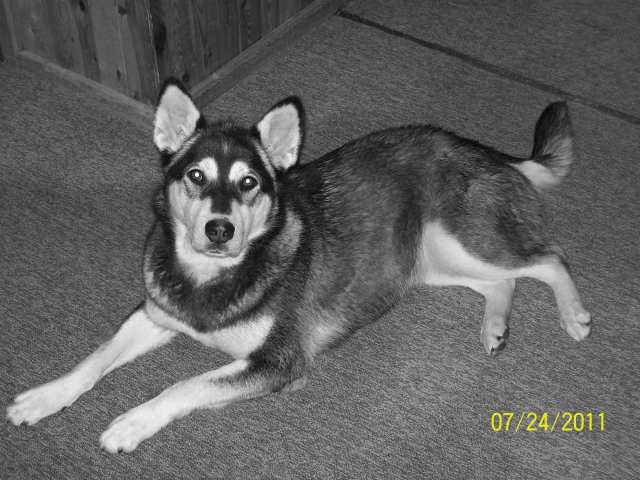 Pregnancy
Question
Diamond in black and w
Is it possible f
Pregnancy
Question
Diamond in black and w
Is it possible f
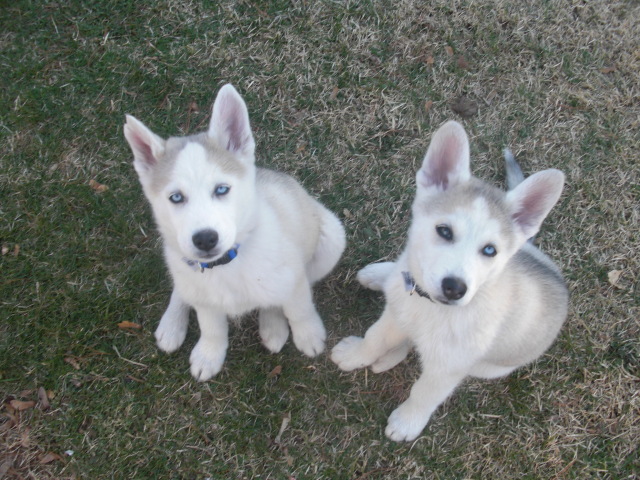 2 12 week old Husky brothers play/fighting
QuestionJasper & Sigmund
QUESTION: Two weeks
2 12 week old Husky brothers play/fighting
QuestionJasper & Sigmund
QUESTION: Two weeks
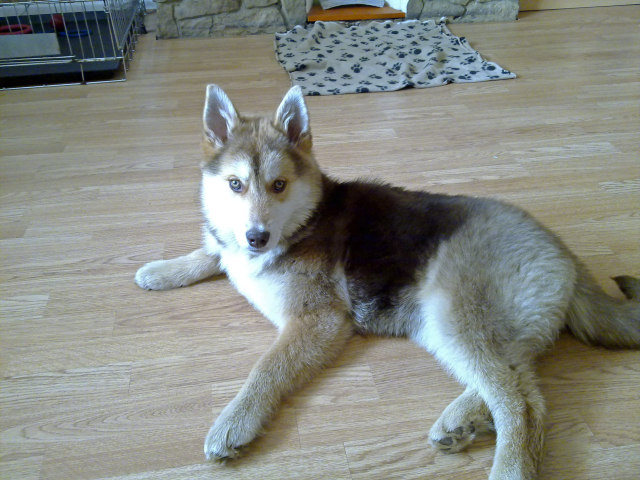 my husky colour
Question
mecca
hi i have recently got my husky mecca. s
my husky colour
Question
mecca
hi i have recently got my husky mecca. s
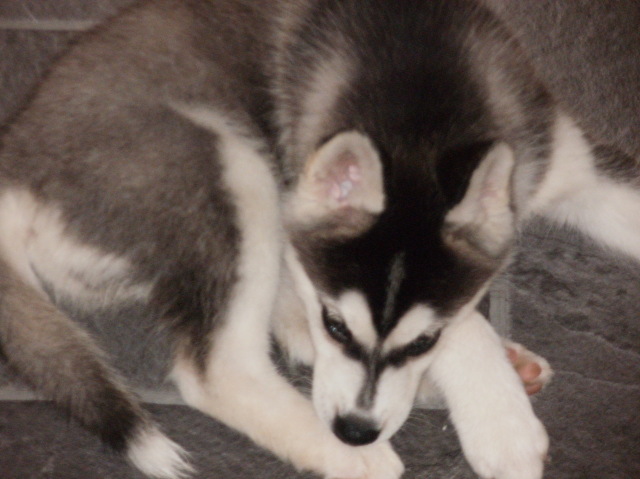 Bath Time
Question
Keiko
Hi we have a 14 week old Siberian named
Bath Time
Question
Keiko
Hi we have a 14 week old Siberian named